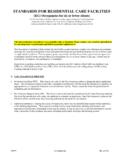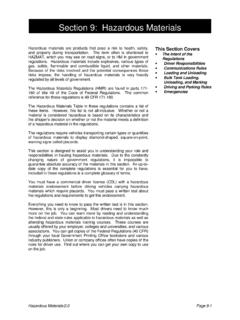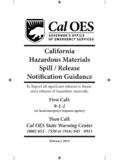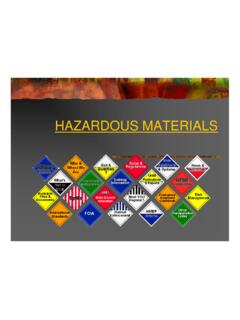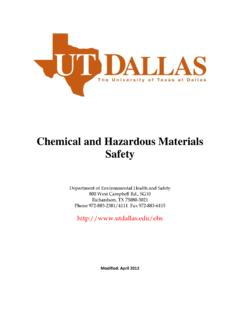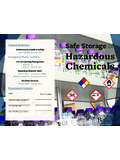Transcription of Marking Requirements and Guidelines for Hazardous ...
1 UN-016 - 1/8 Rev. 02/11/08 Marking Requirements AND Guidelines FOR Hazardous MATERIALS AND Hazardous WASTES For Use by Unidocs Member Agencies or where approved by your Local Jurisdiction Authority Cited: California Fire Code; California Health and Safety Code (HSC); Title 22 California Code of Regulations (CCR) Hazardous Materials Storage Ordinance (HMSO)1, Toxic Gas Ordinance (TGO)1 I. General Information: Hazardous materials and Hazardous waste containers and storage areas shall be marked in order to identify their contents and the hazard(s) posed by them.
2 This document is intended to supplement OSHA and DOT Requirements for maintaining identification and hazard labels on containers and Requirements of the National Fire Protection Association (NFPA) 704 "Standard System for the Identification of the Hazards of Materials for Emergency Response, as adopted by the California Fire Code. NFPA 704 is available for free online viewing at: The NFPA 704 system is the predominant emergency response Marking standard and may be required for buildings and areas containing regulated amounts of Hazardous materials. This document is divided into two main parts: Section III lists Requirements which must be followed, and cites the specific code sections supporting them; Section IV is a collection of Guidelines which, when followed, will assist emergency response personnel in the event of an emergency at your facility.
3 You are strongly encouraged to implement the Guidelines , although they are not required by code. Please note that the Guidelines may not be applicable in all circumstances. If assistance is needed in applying them, contact your local agency. II. Definitions: The following definitions apply with regard to Requirements specified in this document: Chemical Name - The technical chemical identity of a material except where a common term ( , gasoline) is a generally recognized name. Hazard Class - As defined by the United States Department of Transportation (DOT). [See Title 49 Code of Federal Regulations, Part ] Hazardous material - Any non-waste material regulated by federal, state, or local jurisdictions as Hazardous . Hazardous Waste - Any waste material regulated by the State of California as Hazardous waste.
4 III. Requirements : A. General: 1. Markings shall be made of durable materials and shall be replaced as needed due to normal aging and fading. [CFC ] 2. Markings shall be in English. Markings in other languages should be provided where appropriate. [CFC ] 3. Signs prohibiting smoking shall be posted in enclosed Hazardous materials storage/handling areas and within 25 feet of outdoor Hazardous materials storage/handling areas. [CFC ] 1 HMSO and TGO Requirements are applicable only within Santa Clara County. Marking Requirements and Guidelines for Hazardous Materials and Hazardous Wastes - Page 2 of 8 UN-016 - 2/8 Rev.
5 02/11/08 B. Specific for Hazardous Materials: 1. Compressed Gases and Liquefied Gases: a. Stationary compressed gas containers and tanks shall be marked with the name of the gas and NFPA 704 placards. Markings shall be visible from any direction or approach. [CFC ] b. Portable containers, cylinders, and tanks shall be marked in accordance with Compressed Gas Association (CGA) Standard C-7. [CFC ] c. All portable toxic gas tanks and cylinders shall be marked to indicate the valve's orifice size, in inches. The orifice size shall be printed on the certification tag for the portable tank or cylinder as well as on the vessel itself. The lettering shall be a minimum of 1/4" high.
6 [TGO] d. Rooms or cabinets shall be conspicuously labeled COMPRESSED GAS. [CFC ] 2. Piping and Tubing Containing Hazardous Materials Liquids and Gases: a. All exposed piping and tubing, including gas exhaust systems prior to treatment, which contain Hazardous materials shall be marked at intervals no greater than every twenty (20) feet with the name of the material contained and the direction of flow. Lines shall be marked thus at each point where changes in direction occur and where wall, ceiling, or floor penetration occurs. Where lines are shorter than 20 feet in length, such markings shall appear at least once along the length of the run. Where supplementary color identification of piping is used, it shall be in accordance with the Hazardous materials and colors indicated in nationally recognized standards as referenced in the California Fire Code.
7 [CFC and ] b. Emergency control valves and shut-off valves shall be marked to indicate their function. [CFC ] 3. Open Tanks, Vats, and Baths: Open tanks, vats, and baths shall be marked in accordance with NFPA 704. [CFC ] 4. Aboveground Storage Tanks: Aboveground tanks shall be marked in accordance with NFPA 704. [CFC ] 5. Storage Cabinets: a. Cabinets used for the storage of flammable liquids shall be provided with a conspicuous label in red letters on contrasting background which reads FLAMMABLE - KEEP FIRE AWAY. [CFC ] b. Cabinets used for Hazardous materials other than flammable liquids shall be provided with a conspicuous label in red letters on contrasting background which reads Hazardous - KEEP FIRE AWAY.
8 [CFC ] 6. Empty Hazardous Materials Containers: [22 CCR (f)] Each empty container2 larger than 5 gallons which previously held a Hazardous material and is considered a Hazardous waste shall be marked with the date it was emptied. 2 The California Department of Toxic Substances Control (DTSC) Fact Sheet titled Managing Empty Containers (available at ) defines what constitutes an empty container. Marking Requirements and Guidelines for Hazardous Materials and Hazardous Wastes - Page 3 of 8 UN-016 - 3/8 Rev. 02/11/08 [Exceptions: (1) Empty gas cylinders are exempt when the pressure in the container reaches atmospheric pressure; (2) Aerosol cans are exempt provided that they are not a RCRA-regulated Hazardous waste or California extremely Hazardous waste and that the containers are emptied of contents and propellant to the maximum extent practical under normal use; (3) Containers or container liners made of wood, paper, cardboard, fabric, or any other similarly absorptive materials must be managed as Hazardous wastes if they were in direct contact with and have absorbed the Hazardous waste or Hazardous material they held.]
9 (4) Containers or container liners which have held RCRA acutely Hazardous (P List) wastes or California extremely Hazardous wastes must be managed as Hazardous wastes unless they have been triple rinsed or otherwise cleaned in a manner approved by the California Department of Toxic Substances Control.] 7. Stations Dispensing Gasoline or Other Flammable Liquids: a. Conspicuous signs shall be posted within sight of each dispenser prohibiting smoking, dispensing into unapproved containers, and filling portable containers in or on a motor vehicle. The signage shall also instruct the user to discharge static electricity before fueling and to wait until pumping is complete before reentering the vehicle.
10 [CFC ] b. Dispenser operating instructions shall be conspicuously posted in approved locations on every dispenser. [CFC ] c. For unattended self-service dispensing, in addition to the dispensing operating instructions noted above, signage shall include the location(s) of the emergency fuel shut-off switch(es). [CFC ] d. The emergency shut-off switch(es) for the dispensing operation shall be marked "EMERGENCY FUEL SHUTDOWN DEVICE" [CFC ] e. For unsupervised dispensing, the following sign shall be posted in a conspicuous location: [CFC ] IN CASE OF FIRE, SPILL OR RELEASE 1. Use emergency pump shutoff! 2. Report the accident! Fire Department No. 911 Facility address [Note: If applicable, a facility s internal fire department number may be shown on the sign in place of 911.]





